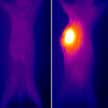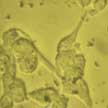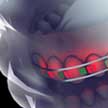Showing Spotlights 161 - 168 of 556 in category All (newest first):
 Researchers propose novel flexible Mn-doped zirconium metal-organic frameworks nanocubes for highly effective combination of microwave dynamic and thermal therapy against cancer. This is the first report of determining the microwave thermal conversion efficiency, which can be used to evaluate, compare, and predict the microwave sensitivity of different microwave-sensitive agents. More importantly, such Mn-ZrMOF nanocubes generate abundant reactive oxygen species of hydroxyl radicals under microwave irradiation.
Researchers propose novel flexible Mn-doped zirconium metal-organic frameworks nanocubes for highly effective combination of microwave dynamic and thermal therapy against cancer. This is the first report of determining the microwave thermal conversion efficiency, which can be used to evaluate, compare, and predict the microwave sensitivity of different microwave-sensitive agents. More importantly, such Mn-ZrMOF nanocubes generate abundant reactive oxygen species of hydroxyl radicals under microwave irradiation.
Jan 8th, 2018
 The role of artificial nanomotors integrated with therapeutic capabilities is a very promising field for clinical applications of medical nanotechnology. Researchers now have demonstrated the intelligent design of nanomotors with a single coating of ferrite, which act as a spacer layer as well as providing therapeutic potential by magnetic hyperthermia. These motors can be remotely maneuvered. The team also tackled the problem of magnetic agglomeration associated with ferromagnetic nanomotors, which limits their biomedical application.
The role of artificial nanomotors integrated with therapeutic capabilities is a very promising field for clinical applications of medical nanotechnology. Researchers now have demonstrated the intelligent design of nanomotors with a single coating of ferrite, which act as a spacer layer as well as providing therapeutic potential by magnetic hyperthermia. These motors can be remotely maneuvered. The team also tackled the problem of magnetic agglomeration associated with ferromagnetic nanomotors, which limits their biomedical application.
Jan 5th, 2018
 Crossing the blood-brain barrier (BBB) is the object of intensive research in nanotechnology and biomedicine for developing new therapies against brain cancer and for the treatment of neurodegenerative diseases. For this reason, it is extremely important to develop realistic models of the BBB, which mimic as most accurately as possible the in vivo environment. The development of high-resolution 3D-printing technologies has now enabled researchers to develop a realistic 3D bio-hybrid microfluidic model of BBB inspired by the in vivo neurovasculature.
Crossing the blood-brain barrier (BBB) is the object of intensive research in nanotechnology and biomedicine for developing new therapies against brain cancer and for the treatment of neurodegenerative diseases. For this reason, it is extremely important to develop realistic models of the BBB, which mimic as most accurately as possible the in vivo environment. The development of high-resolution 3D-printing technologies has now enabled researchers to develop a realistic 3D bio-hybrid microfluidic model of BBB inspired by the in vivo neurovasculature.
Dec 21st, 2017
 Single-atom catalysts (SACs) have emerged as a new frontier in heterogeneous catalysis, and demonstrated distinguishing performances for various reactions due to their high catalytic activity with a significantly reduced amount of metals used. However, the catalytic performance of SACs for nitrogen fixation and conversion has been rarely explored. Scientists now have proposed a quite promising single-atom-based electrocatalyst for N2 reduction to NH3 under ambient conditions.
Single-atom catalysts (SACs) have emerged as a new frontier in heterogeneous catalysis, and demonstrated distinguishing performances for various reactions due to their high catalytic activity with a significantly reduced amount of metals used. However, the catalytic performance of SACs for nitrogen fixation and conversion has been rarely explored. Scientists now have proposed a quite promising single-atom-based electrocatalyst for N2 reduction to NH3 under ambient conditions.
Nov 17th, 2017
 Researchers have demonstrated a novel approach toward smart orthodontics based on near-infrared red light from a mechanically flexible LED powered by flexible bio-safe batteries all integrated in a single 3D-printed dental brace. Integration of electronic devices in 3D printed dental aligners is a pragmatic approach towards implementing a flexible electronic technology in personalized advanced healthcare, particularly in orthodontics. Key to this smart brace is the use of a high-performance flexible solid-state microbattery.
Researchers have demonstrated a novel approach toward smart orthodontics based on near-infrared red light from a mechanically flexible LED powered by flexible bio-safe batteries all integrated in a single 3D-printed dental brace. Integration of electronic devices in 3D printed dental aligners is a pragmatic approach towards implementing a flexible electronic technology in personalized advanced healthcare, particularly in orthodontics. Key to this smart brace is the use of a high-performance flexible solid-state microbattery.
Nov 16th, 2017
 The remarkable properties of some natural materials have motivated many researchers to synthesize biomimetic nanocomposites and other nanostructured materials that attempt to reproduce Nature's achievements. Recent research has indicated that the amplification of natural materials' mechanical properties far beyond those of the components that comprise them originates mainly from: 1) a hierarchical micro-/nanoscale architecture and 2) abundant effective interface interactions. A new progress report provides insight into the development of bio-inspired structural materials.
The remarkable properties of some natural materials have motivated many researchers to synthesize biomimetic nanocomposites and other nanostructured materials that attempt to reproduce Nature's achievements. Recent research has indicated that the amplification of natural materials' mechanical properties far beyond those of the components that comprise them originates mainly from: 1) a hierarchical micro-/nanoscale architecture and 2) abundant effective interface interactions. A new progress report provides insight into the development of bio-inspired structural materials.
Nov 10th, 2017
 The crucial roles of the physicochemical properties of cell culture substrates on function and behavior of a wide range of the cells are becoming well-studied in the current literature, using experimental approaches. However, development of in silico approaches for prediction of cell responses to the physicochemical properties of substrates is still in its infancy. In new work, an international team of researchers has developed a unifying computational framework to create a multi-component virtual cell model to probe cell function/behavior in silico.
The crucial roles of the physicochemical properties of cell culture substrates on function and behavior of a wide range of the cells are becoming well-studied in the current literature, using experimental approaches. However, development of in silico approaches for prediction of cell responses to the physicochemical properties of substrates is still in its infancy. In new work, an international team of researchers has developed a unifying computational framework to create a multi-component virtual cell model to probe cell function/behavior in silico.
Nov 1st, 2017
 Researchers explore cellular uptake, endocytic pathways, and intracellular dynamics of nanoparticles in HeLa cells, both in absence and presence of biomolecular corona from human plasma. They find that the biomolecular corona could act as a personalized 'endogenous trigger' affecting off-target interactions and controlling the indication for disease of clinically approved formulations. Mechanistic investigations of the biomolecular corona could contribute to a better understanding of the poor success of targeted liposomal technology.
Researchers explore cellular uptake, endocytic pathways, and intracellular dynamics of nanoparticles in HeLa cells, both in absence and presence of biomolecular corona from human plasma. They find that the biomolecular corona could act as a personalized 'endogenous trigger' affecting off-target interactions and controlling the indication for disease of clinically approved formulations. Mechanistic investigations of the biomolecular corona could contribute to a better understanding of the poor success of targeted liposomal technology.
Oct 23rd, 2017
 Researchers propose novel flexible Mn-doped zirconium metal-organic frameworks nanocubes for highly effective combination of microwave dynamic and thermal therapy against cancer. This is the first report of determining the microwave thermal conversion efficiency, which can be used to evaluate, compare, and predict the microwave sensitivity of different microwave-sensitive agents. More importantly, such Mn-ZrMOF nanocubes generate abundant reactive oxygen species of hydroxyl radicals under microwave irradiation.
Researchers propose novel flexible Mn-doped zirconium metal-organic frameworks nanocubes for highly effective combination of microwave dynamic and thermal therapy against cancer. This is the first report of determining the microwave thermal conversion efficiency, which can be used to evaluate, compare, and predict the microwave sensitivity of different microwave-sensitive agents. More importantly, such Mn-ZrMOF nanocubes generate abundant reactive oxygen species of hydroxyl radicals under microwave irradiation.
 Subscribe to our Nanotechnology Spotlight feed
Subscribe to our Nanotechnology Spotlight feed





